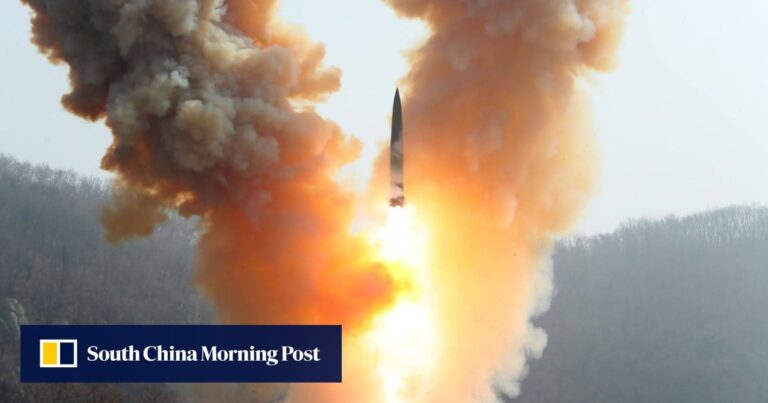According to the Federation of American Scientists think tank, the Agni-5 MIRV (Multiple Independently Targetable Reentry Vehicle)-type test conducted on March 11 was a sign that China could develop an early MIRV-capable DF-5 intercontinental ballistic missile. It is believed that this is in response to the deployment of the
In 2017, Pakistan conducted its first test-fire of the MIRV-capable medium-range ballistic missile Ababil. The country is awaiting delivery of eight Chinese-designed Hangor-class submarines that are believed to be capable of carrying Babur-3 nuclear-armed cruise missiles.
Wilfred Wang, director of the Weapons of Mass Destruction Program at the Stockholm International Peace Research Institute, said: “South Asia has what some people call a ‘strategic linkage’, with regional and sub-regional It is characterized by the interconnectedness of strategic competition and downwind effects. . “MIRV’s emphasis reflects this.”

But Sean Rostker, a research analyst at the Washington-based Arms Control and Nonproliferation Center, said it would still be “likely several years” before both India and Pakistan could deploy nuclear-powered submarines. ”.
“It will be some time before either side deploys underwater missiles, and it will be even longer before such missiles are nuclear capable,” he said.
Israel denies having nuclear weapons, but is widely believed to have or are developing MIRV technology. The country reportedly launched its newest German submarine in August last year. Analysts claim this and other Israeli submarines could carry nuclear-tipped missiles.

If that happens, Israel will now be the only nuclear state in the Middle East, while Iran is known as a nuclear power because of its ability to manufacture warheads.
For example, India’s Agni-5 MIRV test, widely seen by analysts as a response to recent Chinese deployments, may itself have been a response to capability development on the U.S. side, Wang said. Stated.
“There is no single factor driving this MIRV development,” said Masao Dahlgren, a missile defense project fellow at the Washington Center for Strategic and International Studies.
“There are clearly changes in the external security environment,” including China’s sudden nuclear buildup, he said. But domestic political changes may also have an impact.
“Guardrails have been removed.”
Analysts say the acquisition of MIRV technology could tempt ambitious national leaders to adopt a more threatening nuclear posture rather than relying solely on such weapons as a deterrent. They point to Russia’s increasingly aggressive posture since its invasion of Ukraine in February 2022 as an example.
In recent decades, Russia has replaced nearly all of its Soviet-era nuclear weapons with modern systems. The process included replacing single-warhead intercontinental ballistic missiles with MIRVs and upgrading the submarine fleet to carry more new multi-warhead missiles. Headed cruise missile.
A new Borei-class nuclear-powered submarine capable of carrying 16 ballistic missiles with MIRV warheads has also been launched, half of which will remain on the Pacific coast, and a few Soviet-era Delta-class submarines remain in the Russian Navy. Replaces nuclear submarines.

However, the US government continues to maintain a fleet of nuclear-capable bombers and ballistic missile submarines in the Asia-Pacific region, as well as a stockpile of B61 tactical nuclear bombs intended for operations in the region.
Why North Korea refuses to talk with the US: The regime “will never negotiate if it feels strong”
Why North Korea refuses to talk with the US: The regime “will never negotiate if it feels strong”
The United States and Russia together possess about 90% of the world’s nuclear warheads; the Federation of American Scientists estimates that Russia has about 5,580 warheads and the United States has 5,044, including those retired, stockpiled, and in reserve. It is estimated that it is in possession.
The treaty known as New START, which took effect in 2011, limits the number of strategic warheads each country can deploy to a maximum of 1,550, with additional limits on ICBMs and bombers. As the deadline approaches in 2026, fears of a new nuclear arms race are growing.
An earlier treaty known as START-II prohibited MIRV-capable intercontinental ballistic missiles, but it never went into effect.
“Arms control and disarmament architecture is deteriorating. Guardrails to avert the risk of nuclear war and avoid an arms race are being removed,” Wang said, adding that military modernization plans of nuclear-weapon states are “worsening around the world.” “This is contributing to further destabilization of the order,” he added.
The United States has not yet adopted a more aggressive nuclear posture in response to Russia’s moves, although an October report from the Congressional Strategic Posture Committee calls for such a nuclear buildup.
We live in a much more complex world today than during the Cold War, when the nuclear race was limited to two superpowers.
When New START expires in two years, the United States and Russia could “add hundreds of warheads to already deployed systems” in the coming weeks or months, according to the Federation of American Scientists. warned the moon.
A U.S. think tank that provides expertise and analysis on arms control and nonproliferation estimates that China currently has about 500 nuclear warheads, and the Department of Defense predicts that China will have nearly 500 nuclear warheads by 2030. He says he wants to double the amount.
India and Pakistan are estimated to have 164 and 170 warheads, respectively, while Israel has 90 and is said to have stockpiled enough fissile material to produce 200. It is considered.
Experts estimate that North Korea has assembled about 40 to 50 warheads.
“The accumulation of nuclear weapons anywhere threatens to destabilize everywhere,” said Rostker, a nonproliferation researcher.
“We live in a much more complex world today than during the Cold War, when the nuclear race was limited to two superpowers.”


